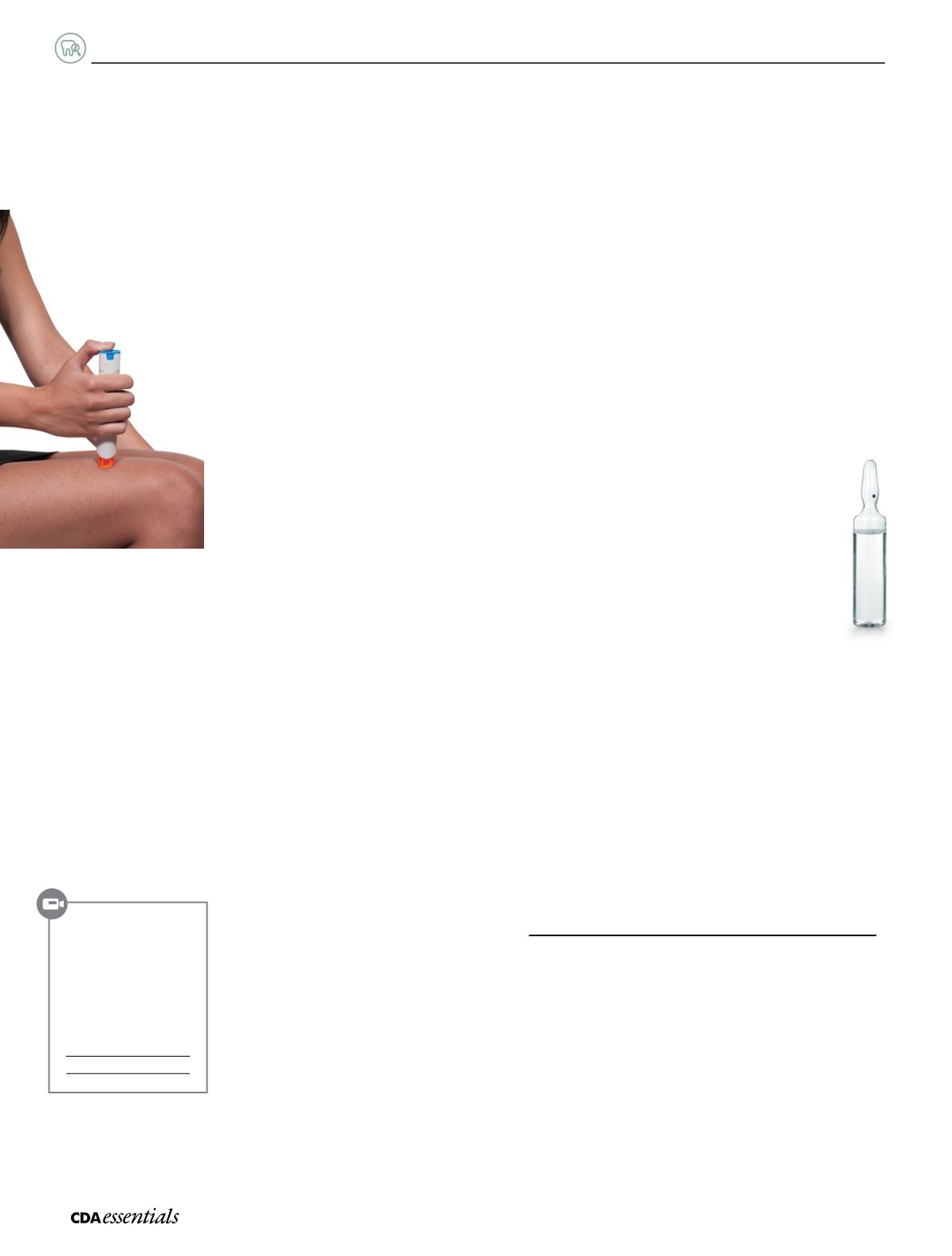

28
|
Volume 3 Issue 6
S
upporting
Y
our
P
ractice
Administration of Epinephrine
Dr. Mark Donaldson, a pharmacist and member of
the
Journal of the American Dental Association
editorial
board, says that epinephrine is one of the drugs that
should make up the minimal emergency kit of any
dental office. Epinephrine opens up the airways,
helps decrease swelling and increase blood pressure,
and increases heart rate (which can help prevent
cardiovascular events).
Auto-Injectors
The most commonly known epinephrine auto-injector
is the EpiPen® (Pfizer). Some may also have used the
Allerject® auto-injector, but it is no longer available
following a voluntary recall of all lots in late 2015 as
“they were found to potentially have inaccurate dosage
delivery,” explained Sanofi in a press release.
4
While they are the only option available to
patients themselves, auto-injectors might not
be the best suited option for a dental practice,
warns Dr. Donaldson. Additionally, they are
the most expensive option and have a shelf
life of only 18 months.
• Many units are required.
“Epinephrine has a
half-life of about 2 minutes, which means that if
the emergency medical team cannot get to your
office within minutes, you may have to administer
a second dose. And in some cases, especially if
you practice in a remote area or if you’re dealing
with a patient who’s a hyporesponder (i.e., shows
little response to epinephrine injection), you may
in fact need a third dose. So I would recommend
that dentists carry at least 3 EpiPen® devices at their
practice.” Dentists treating pediatric patients should
also carry at least 3 EpiPen® Jr devices.
• Safety of use.
To ensure that people are
comfortable using an EpiPen®, Pfizer created the
EpiPen® Training Device. This device is identical in
shape and size to the real injector, but it
doesn’t contain a needle or medication.
Although it comes with a different colour
label and the mention “training device”,
its similarities with the actual EpiPen® lead
many people to confuse one for the other.
Training devices should never be kept in the
emergency kit or with the actual EpiPen®.
Occurrences of health care professionals
accidentally self-injecting epinephrine
in a digit because they held the EpiPen®
incorrectly are also fairly common, according
to Dr. Donaldson.
• Efficacy.
“Auto-injectors all have a 25-gauge,
½ inch needle. Yet the literature shows that
you need at least a 3 cm (~1.2 inches) needle to
correctly deposit the medication into the vascular
bed within the vastus lateralis thigh muscle for the
epinephrine to be taken up in the blood system
back to the heart. That is why manufacturers tell
patients to continue to hold and press for at least
10 seconds after self-injecting.” And it might be
even more difficult to reach the vascular bed in
patients who are overweight. When contacted
by Dr. Donaldson, Pfizer responded that “the
EpiPen® Prescribing Information does not address
dosing considerations in the pediatric and adult
populations that are overweight or obese. There
are uncertainties about appropriate needle length
required for intramuscular dosing in patients who
are overweight or obese.”
Ampules
The single epinephrine ampule 1:1000 (1 mg/mL)
might be a better option for dentists, based on
efficacy, safety, cost, and shelf life (about 2 years).
Never manipulated glass ampules? Given the
very low cost of epinephrine ampules, “you
can get many, practise often and get skilled at
removing the medication in a timely fashion,”
says Dr. Donaldson. To break into an ampule,
he suggests placing a 2” x 2” piece of gauze
around the neck of the ampule and exerting some
pressure. The neck will snap, giving you access to the
epinephrine. Using a syringe with an appropriate length
needle, administer 0.3 mL (0.3 mg) [or 0.15 mL (0.15 mg)
for pediatric patients] in the patient’s vastus lateralis
muscle at a 90-degree angle. Should the patient need a
second or third dose, simply inject another 0.3 mL dose.
Vials
Although a little more expensive than the ampules,
1-mL (1 mg) epinephrine vials can be an alternative
for those who do not want to manipulate glass
ampules.
a
R
eferences
1.HealthCanada[Internet].
SevereAllergicReactions
;2008Oct24[accessed2016Jan7].Available
from:hc-sc.gc.ca/hl-vs/iyh-vsv/med/allerg-eng.php2.CanadianSocietyofAllergyandClinical Immunology.
Anaphylaxis inSchools&OtherSettings.3rd
Edition
[Internet].2014[accessed2016Jan7].Available
from:csaci.ca/patient-school-resources/3.FoodAllergyCanada[Internet].DidYouKnow?;2016[accessed2016Jan7].Available from:
foodallergycanada.ca/about-allergies/anaphylaxis4,Sanofi[Internet].
SanofiCanada issuesvoluntarynationwiderecallofAllerject®duetopotential
inaccuratedosagedelivery
;2015Oct28[accessed2016Jan29].Available from:http://
sanoficanada.mediaroom.com/2015-10-28-Sanofi-Canada-Issues-Voluntary-Nationwide-Recall-of-Allerject-Due-to-Potential-Inaccurate-Dosage-Delivery
To learn more about
the administration
of epinephrine and
the options available
to dentists, watch
an interview with
Dr. Donaldson at
oasisdiscussions.ca /2015/11/09/epipen















